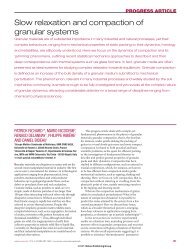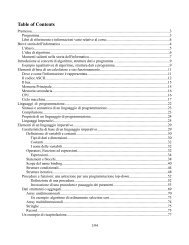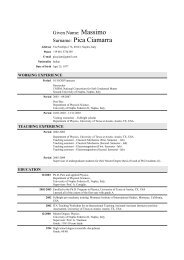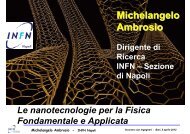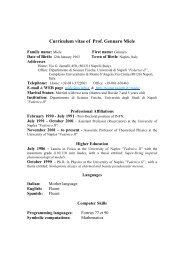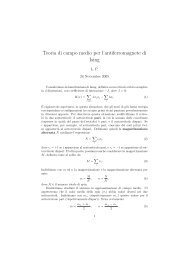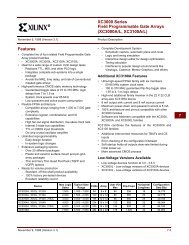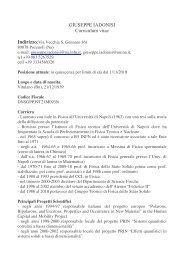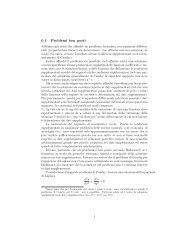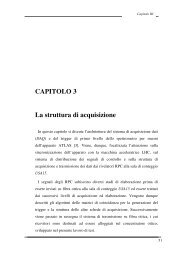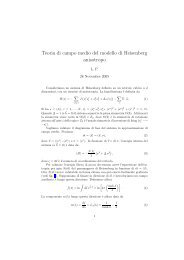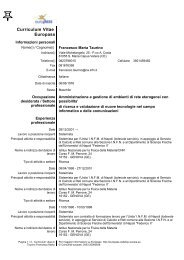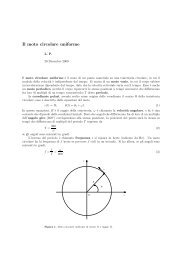Phys Rev E
Phys Rev E
Phys Rev E
Create successful ePaper yourself
Turn your PDF publications into a flip-book with our unique Google optimized e-Paper software.
Light-induced rotation of dye-doped liquid crystal droplets<br />
C. Manzo, D. Paparo, and L. Marrucci*<br />
Dipartimento di Scienze Fisiche, Università “Federico II” and INFM-CNR Coherentia,<br />
Complesso di Monte S. Angelo, via Cintia, 80126 Napoli, Italy<br />
I. Jánossy<br />
Research Institute for Solid State <strong>Phys</strong>ics and Optics, H-1525 Budapest, Hungary<br />
Received 9 December 2005; published 17 May 2006<br />
We investigate both theoretically and experimentally the rotational dynamics of micrometric droplets of<br />
dye-doped and pure liquid crystal induced by circularly and elliptically polarized laser light. The droplets are<br />
dispersed in water and trapped in the focus of the laser beam. Since the optical torque acting on the molecular<br />
director is known to be strongly enhanced in light-absorbing dye-doped materials, the question arises whether<br />
a similar enhancement takes place also for the overall optical torque acting on the whole droplets. We searched<br />
for such enhancement by measuring and comparing the rotation speed of dye-doped droplets induced by a laser<br />
beam having a wavelength either inside or outside the dye absorption band, and also comparing it with the<br />
rotation of pure liquid crystal droplets. No enhancement was found, confirming that photoinduced dye effects<br />
are only associated with an internal exchange of angular momentum between orientational and translational<br />
degrees of freedom of matter. Our result provides also direct experimental proof of the existence of a photoinduced<br />
stress tensor in the illuminated dye-doped liquid crystal. Finally, peculiar photoinduced dynamical<br />
effects are predicted to occur in droplets in which the molecular director is not rigidly locked to the flow, but<br />
so far they could not be observed.<br />
DOI: 10.1103/<strong>Phys</strong><strong>Rev</strong>E.73.051707 PACS numbers: 61.30.Pq, 61.30.Gd, 42.50.Vk, 42.70.Gi<br />
I. INTRODUCTION<br />
It has been known since the early 1980s that light can<br />
transfer its angular momentum to liquid crystals with high<br />
efficiency, causing the rotation of the average molecular orientation,<br />
as specified by the molecular director 1.<br />
In the early 1990s it was discovered that by adding small<br />
amounts of certain dyes to the liquid crystals, the lightinduced<br />
torque on the molecular director could be greatly<br />
enhanced 2,3. This effect, initially rather puzzling, was<br />
later explained by a model relying on the reversible changes<br />
of intermolecular forces occurring between photoexcited dye<br />
molecules and liquid crystal host 4. This model was subsequently<br />
extended and refined 5 and confirmed with several<br />
independent experiments 6–10.<br />
The understanding achieved with this model has also provided<br />
an answer to a fundamental question related to the<br />
observed torque enhancement: Where does the additional angular<br />
momentum come from? Clearly, the angular momentum<br />
that is transported by the optical wave impinging on the<br />
material cannot be affected by the presence of dye. It is true<br />
that absorption of light due to the dye does lead to some<br />
additional transfer of angular momentum from light to matter<br />
and therefore to a variation of the light-induced torque. However,<br />
this effect cannot account for the magnitude of the observed<br />
torque enhancement 6 and for its peculiar dyestructure<br />
dependence 7. The clearest solution to this puzzle<br />
was put forward in Refs. 5,11 and is as follows. The angular<br />
momentum transfer from light is indeed approximately<br />
unchanged. Light absorption, however, triggers a transfer of<br />
*Electronic address: lorenzo.marrucci@na.infn.it<br />
PHYSICAL REVIEW E 73, 051707 2006<br />
angular momentum between different internal degrees of<br />
freedom of the liquid crystal, namely from the center-of-mass<br />
molecular degrees of freedom, corresponding macroscopically<br />
to fluid flow, to the molecular-orientation degrees of<br />
freedom, corresponding to the molecular director. Being an<br />
internal transfer, the total angular momentum given to the<br />
material as a whole is not affected by the presence of dye.<br />
Another consequence of this internal transfer is that, by the<br />
force action-reaction principle, in dye-doped liquid crystals<br />
there should be another opposite torque acting on the fluid<br />
in the form of a photoinduced stress tensor 5.<br />
However plausible they may be, both these predictions<br />
have never been tested directly in an experiment. Here we<br />
address these questions by studying the rotational behavior<br />
of pure and dye-doped liquid crystal droplets of micrometric<br />
size, optically trapped in water, under the effect of circularly<br />
and elliptically polarized infrared and visible laser light. In<br />
particular, we measured the rotation speed of dye-doped<br />
droplets illuminated with visible light, having a wavelength<br />
in the dye absorption domain, and compared it with that of<br />
undoped droplets and with the case in which the illumination<br />
is by infrared light, not absorbed by the dye. Should we<br />
observe some significant dye-induced enhancement or other<br />
anomalies of the droplet rotation speed, this would imply<br />
that the current understanding of the photoinduced torque as<br />
entirely due to an internal exchange of angular momentum is<br />
not correct, or at least not complete.<br />
But what do we exactly mean by droplet rotation? From a<br />
theoretical point of view, a liquid crystal droplet actually has<br />
two independent rotational degrees of freedom: the average<br />
molecular director, corresponding to the average orientation<br />
of the liquid crystal molecules in the droplet, and the internal<br />
rotational flow, corresponding to a fluidlike motion of the<br />
molecule centers of mass this is already a strong simplifica-<br />
1539-3755/2006/735/05170714 051707-1<br />
©2006 The American <strong>Phys</strong>ical Society
MANZO et al. PHYSICAL REVIEW E 73, 051707 2006<br />
tion: a liquid crystal droplet has actually an infinite number<br />
of rotational degrees of freedom associated with changing<br />
inhomogeneous configurations of director and flow. These<br />
two rotational degrees of freedom of the droplet are always<br />
strongly interacting with each other, via viscosity, elastic<br />
forces, and possibly also photoinduced effects. This interaction<br />
may be strong enough to lock the two degrees of freedom<br />
together into a single one, so that the droplet effectively<br />
behaves as a rigid body. This is what we actually observed in<br />
our experiments. Nonetheless, by properly choosing the experimental<br />
parameters, it should be possible to reach a regime<br />
in which the two rotational degrees of freedom become<br />
effectively unlocked. We would expect that in this “unlocked”<br />
regime, photoinduced dye effects become important,<br />
even if the angular momentum exchange is entirely internal.<br />
We investigated theoretically this case and predicted the occurrence<br />
of highly nontrivial photoinduced rotational effects,<br />
which we then tried to observe experimentally.<br />
This paper is organized as follows. The general continuum<br />
theory of the light-induced dynamics of dye-doped<br />
liquid crystals is reviewed in Sec. II. In Sec. III, we then<br />
apply this theory to the case of a spherical droplet immersed<br />
in water. With the help of several strongly simplifying<br />
approximations, analytical solutions are found, predicting<br />
what should be the light-induced rotational behavior of the<br />
droplets as a function of light power and polarization and<br />
of droplet size. Our experiments are then described and<br />
discussed in Sec. IV. Our results are finally summarized in<br />
Sec. V.<br />
II. GENERAL THEORY OF PHOTOINDUCED<br />
DYNAMICS OF NEMATICS<br />
A. Dynamical fields and equations<br />
In general, the dynamics of a nematic liquid crystal under<br />
the action of laser light is defined by the temporal and spatial<br />
dependence of the following fields: i the molecular director<br />
n specifying the local average molecular alignment 12, ii<br />
the velocity vector v defining the flow of matter, and iii the<br />
electric and magnetic fields of the optical wave, E and B,<br />
respectively.<br />
The optical fields E and B are governed by the usual<br />
electromagnetic Maxwell equations in anisotropic dielectric<br />
media 13. The two material fields n and v are, respectively,<br />
governed by the director torque balance equation,<br />
d<br />
In <br />
dtn dn<br />
<br />
dt= tot 1<br />
and by the Newton equation for the acceleration or momentum<br />
conservation law,<br />
dvi dt = tot<br />
jtji , 2<br />
where j stands for the partial derivative /x j and the usual<br />
sum convention over repeated indices is understood. In these<br />
equations, tot is the total torque density acting on the molecular<br />
director, ttot is the total stress tensor associated with a<br />
fluid displacement with no director rotation this corresponds<br />
to Ericksen’s definition of stress tensors in liquid crystals<br />
14, I n is a moment of inertia per unit volume associated<br />
with the rotation of the nematic director, which is actually<br />
negligible in all practical cases it is included only for making<br />
the equation physical meaning clearer, and is the mass<br />
density, hereafter assumed to be constant incompressible<br />
fluid approximation. Moreover, in both equations above we<br />
have used the so-called “material” or “convective” time derivative,<br />
defined as d/dt=/t+v j j, corresponding to a derivative<br />
taken following the fluid element along its motion.<br />
Incompressibility actually adds the following constraint on<br />
the velocity field v:<br />
ivi =0, 3<br />
which is a particular case of the mass continuity equation.<br />
B. Constitutive equations<br />
Equations 1 and 2 are to be completed with the appropriate<br />
constitutive equations for the total torque density and<br />
stress tensor. To first order in all deviations from equilibrium<br />
and in all gradients, we may distinguish five additive and<br />
independent contributions to both the torque density and the<br />
stress tensor 14,15: hydrostatic pressure hp, elastic el,<br />
viscous vis, electromagnetic em, and photoinduced ph,<br />
the latter being that associated with dye effects. In summary,<br />
one may write<br />
and<br />
051707-2<br />
tot = <br />
4<br />
tot <br />
tji = tji. 5<br />
<br />
Each of the ten and t =hp, el, vis, em, ph terms<br />
appearing in these two equations has a well-defined firstorder<br />
constitutive dependence on the dynamical fields,<br />
which we will now briefly discuss.<br />
First, there is actually no torque density associated to<br />
pressure effects, i.e., hp =0 identically. The hp stress tensor<br />
hp<br />
term has instead the usual simple form tji =−pji, where p is<br />
the pressure field and ij is the Kronecker delta. In the<br />
incompressible-fluid approximation we are adopting, p must<br />
be treated as a pure “constraint force,” i.e., assuming just the<br />
space and time dependence needed to ensure continuous validity<br />
of Eq. 3.<br />
Next, the constitutive laws of the elastic and viscous<br />
torque densities and stress tensors are fully standard and we<br />
refer to Refs. 14 or 15 for their explicit expressions.<br />
Let us now turn to the electromagnetic terms. They are<br />
also standard, but it is nevertheless convenient to introduce<br />
them explicitly here. We assume for the time being that the<br />
electromagnetic fields present in our systems are associated<br />
only with an approximately monochromatic optical wave<br />
having a given vacuum wavelength . Let us first introduce<br />
the uniaxial optical dielectric tensor of the liquid crystal<br />
ij = 0ij + anin j, 6<br />
where 0 is the vacuum dielectric constant, the relative<br />
dielectric constant for En, and a the relative dielectric
LIGHT-INDUCED ROTATION OF DYE-DOPED LIQUID¼ PHYSICAL REVIEW E 73, 051707 2006<br />
anisotropy. Neglecting all magnetic effects at optical frequencies,<br />
the electromagnetic torque density is then given by<br />
em = D E = 0 an · En E, 7<br />
where D is the usual dielectric displacement field D i<br />
= ijE j and where denotes a time average over an optical<br />
cycle. The electromagnetic stress tensor can be written in the<br />
following form 13,16:<br />
em<br />
tji =F ˜<br />
em − F˜ 0 em<br />
ji + DjEi + BjBi/ , 8<br />
<br />
where 0 is the vacuum magnetic permittivity constant and<br />
F˜ em is the electromagnetic free energy density at given electric<br />
field E and magnetic field strength H=B/ 0, which in<br />
our case can be written as<br />
F˜<br />
em =− 1<br />
2 ijEiEj − B2<br />
=−<br />
20 0 2 ij + anin jEiE j − B2<br />
.<br />
20 9<br />
Let us finally consider the photoinduced terms, i.e., those<br />
appearing in dye-doped liquid crystals when illuminated with<br />
light having a wavelength falling within the dye absorption<br />
band. These are absolutely nonstandard. In the limit of small<br />
light intensities, simple symmetry arguments show that the<br />
photoinduced torque density must be identical to the electromagnetic<br />
one except for the replacement of the dielectric<br />
anisotropy a with a new material constant , proportional to<br />
the absorbance or to dye concentration 5. Therefore its<br />
explicit expression can be written as follows:<br />
ph = 0n · En E 10<br />
the constant 0 is inserted for making dimensionless.<br />
Similarly, we may apply symmetry arguments for identifying<br />
the most general possible expression of the photoinduced<br />
stress tensor. This expression contains seven unknown material<br />
constants all proportional to the absorbance:<br />
ph<br />
tij = a1E2 + a2n · E2ij + a3EiE j + a4E2 + a5n · E2nin j + n · Ea6Ein j + a7Ejni. 11<br />
The effects of this stress tensor have not been measured or<br />
even detected in ordinary liquid crystals, although related<br />
photoinduced effects may have been observed in polymeric<br />
nematic elastomers 17,18.<br />
We have thus completed the set of constitutive equations<br />
needed to close the dynamical equations 1 and 2.<br />
C. Angular momentum conservation<br />
Before moving on to the specific case of a droplet of<br />
liquid crystal immersed in water, it is convenient to see how<br />
the law of angular momentum conservation enters our problem.<br />
In contrast to the case of the conservation of linear momentum,<br />
which provides an additional dynamical equation,<br />
the law of angular momentum conservation actually sets<br />
only a general constraint on the possible constitutive laws of<br />
051707-3<br />
torque densities and stress tensors. For any given volume V<br />
of material, the corresponding angular momentum rate of<br />
change will be given by the following law:<br />
dL<br />
dt = Mtot , 12<br />
where L is the total angular momentum within volume V and<br />
M tot is the total external torque acting on it. The two sides of<br />
Eq. 12 can be deduced by multiplying the corresponding<br />
sides of Eq. 2 vectorially by r, integrating them over the<br />
volume V, and then adding to them the volume integral of<br />
the corresponding sides of Eq. 1. In this way we obtain<br />
and M tot = M , with<br />
L = Vr v + I nn dn<br />
dtdV 13<br />
<br />
Mi = ijhxjktkh + i dV, 14<br />
V<br />
where ijh is the fully antisymmetric Levi-Civita tensor 19.<br />
However, in order for Eq. 12 to be equivalent to a local<br />
conservation continuity law, it should be possible to reduce<br />
the total external torque to a pure surface integral over the<br />
boundary V of V, such as the following:<br />
<br />
Mi = ijhxjtkh + njskhdAk, 15<br />
V<br />
<br />
where skh is a material tensor expressing the torque per unit<br />
area exchanged by the director n directly through the surface<br />
and dAk denotes a vector having direction equal to the local<br />
surface normal pointing outward and modulus equal to the<br />
area of the surface element 14,15.<br />
By equating the two expressions 14 and 15 of the external<br />
torque for any possible volume V, and exploiting the<br />
standard divergence theorems, one obtains the local identity<br />
<br />
i = ijhtjh + kijhnjskh. 16<br />
Generally speaking, this identity holds true only for =tot,<br />
and not separately for each term =hp,el,vis,em,ph. However,<br />
since in our first-order theory these five terms can be<br />
tuned independently from each other, identity 16 must hold<br />
true also for =hp,el,vis,em,ph, separately.<br />
Moreover, since in the first-order approximation only the<br />
elastic forces torque density and stress tensor are taken to<br />
depend on the director spatial gradients, we may deduce<br />
<br />
from Eq. 16 that skh is nonzero only for the elastic contribution<br />
=el. In all other cases one must have s =0 within<br />
first-order approximation. Therefore in these cases, owing to<br />
angular momentum conservation, the stress tensor defines<br />
completely the torque density, or conversely, the torque density<br />
defines the antisymmetric part of the stress tensor. In<br />
particular, Eq. 16 with =ph yields the following relationship<br />
between the material constants appearing in expressions<br />
10 and 11:
MANZO et al. PHYSICAL REVIEW E 73, 051707 2006<br />
0 = a7 − a6. 17<br />
In concluding this section, we note that the theory we have<br />
just described and in particular the constitutive equations we<br />
have adopted for the photoinduced torque density and stress<br />
tensor already imply that the photoinduced angular momentum<br />
transfer associated with the dye is fully internal to the<br />
liquid crystal. Indeed, the flux of angular momentum through<br />
any boundary surface, as given by Eq. 15, will vanish identically<br />
if the stress tensor vanishes on it. Since we have assumed<br />
that all material constants ai are proportional to the<br />
dye concentration, they should vanish on a surface lying just<br />
outside the liquid crystal in water and therefore the flux of<br />
angular momentum through such a surface will vanish, i.e.,<br />
one has Mph =0. We note that the same argument does not<br />
hold for Mem ,astem has a finite value also in the isotropic<br />
liquid.<br />
Is there a possible way out of this conclusion, justifying<br />
perhaps a hypothetical photoinduced flow of angular momentum<br />
out of the liquid crystal? Within a first-order theory<br />
of the constitutive equations the answer is no. However, it<br />
cannot be a priori excluded that higher-order terms in the<br />
constitutive equations become important in specific situations<br />
and justify a strong exchange of angular momentum<br />
with the outside. For example, at the surfaces between the<br />
liquid crystal and the surrounding medium, the mass and<br />
composition densities suffer sharp discontinuities. Therefore<br />
a first-order theory in the spatial gradients is clearly not justified<br />
anymore this, by the way, is just how surface anchoring<br />
enters the problem. It would then be conceivable that<br />
higher-order terms in the photoinduced torque density and<br />
stress-tensor expressions could give rise to photoinduced surface<br />
effects leading to a significant angular momentum exchange<br />
with the outside, i.e., to a Mph0. In the end, this<br />
hypothesis can only be tested, and eventually ruled out, experimentally.<br />
III. DROPLET ROTATIONAL DYNAMICS<br />
Equations 1–3, supplemented with all constitutive<br />
equations for torque densities and stress tensors, completely<br />
define the light-induced dynamics of the liquid crystal. In the<br />
case of a droplet of liquid crystal immersed in water one<br />
should also include in the system the appropriate boundary<br />
conditions at the droplet surface. We limit ourselves to mentioning<br />
them: continuity of fluid velocity and forces across<br />
the boundary, continuity of tangential components of E and<br />
of normal components of D, continuity of B, and appropriate<br />
anchoring conditions on n. Moreover, one should account for<br />
the dynamics of the water surrounding the droplet. The latter<br />
is also governed by Eq. 2, but with a simpler expression of<br />
the stress tensor, including only hydrostatic pressure, Newtonian<br />
viscosity, and the electromagnetic stress tensor.<br />
The resulting system of equations is clearly very complex<br />
and an exact solution can be determined only numerically. In<br />
the following, we instead approach the problem analytically<br />
with the help of several approximations.<br />
First, we will assume that the droplet is always perfectly<br />
spherical, with a radius R and a total mass m spherical<br />
051707-4<br />
droplet approximation SDA. This is an approximation because<br />
anchoring effects combined with elastic interactions<br />
may actually slightly distort the shape of the droplet into an<br />
ellipsoid. The molecular director configuration within the<br />
droplet will be taken to be axial, namely the director n has a<br />
well-defined uniform direction close to the center of the<br />
droplet, while it will be distorted to some extent close to the<br />
surface due to anchoring 20,21,24. This allows one to properly<br />
define an average molecular director of the droplet.<br />
Second, for calculating exactly the overall electromagnetic<br />
torque acting on the droplet we would have to determine<br />
in all details the light propagation within the spherical<br />
droplet, including all the birefringence and wave diffraction<br />
Mie scattering effects: an exceedingly complex task. Instead,<br />
following a common practice in the literature 22–24,<br />
we will use an approximate expression of the electromagnetic<br />
torque obtained by simply replacing the spherical droplet<br />
with a homogeneous slab of liquid crystal having a thickness<br />
equal to the droplet diameter and the strongly focused<br />
light beam with a plane wave planar symmetry approximation<br />
PSA. This approximation will tend to become more<br />
exact in the limit of large droplets and weakly focused light<br />
beams.<br />
Third, we will restrict the possible dynamics of the fluid<br />
and the director to either one of the following two approximate<br />
models: i the droplet behaves exactly as a rigid body,<br />
i.e., rotating only as a whole and with the director perfectly<br />
locked to the fluid rigid body approximation RBA; or<br />
ii the droplet fluid flow and director are allowed to have<br />
different, although uniform, rotation dynamics but the director<br />
field is taken to be perfectly uniform uniform director<br />
approximation UDA.<br />
Let us now go into the details of the outlined approximations.<br />
The SDA approximation needs no further comments,<br />
so we move on to the calculation of the total electromagnetic<br />
torque acting on the droplet within the PSA approximation.<br />
A. Total external electromagnetic torque<br />
We assume that a focused light beam passes through a<br />
liquid crystal droplet and that the average molecular director<br />
inside the droplet is oriented perpendicular to the beam axis.<br />
We choose a reference system in which the z axis coincides<br />
with the beam axis and the average molecular director lies in<br />
the xy plane. Note that, even if initially the average director<br />
of the droplet will not necessarily lie in the xy plane, the<br />
electromagnetic torque itself will force it there, in order to<br />
align the director to the optical electric field. So, at steady<br />
state, our assumption will be always verified.<br />
In order to calculate the total electromagnetic torque we<br />
must use either Eq. 14 or Eq. 15, with =em and with<br />
expressions 7 and 8 of the torque density and stress tensor,<br />
respectively. The main difficulty is that the field to be<br />
used in the integrals is the total one, including both the external<br />
input field and the diffracted or scattered one. Neglecting<br />
the latter will give a vanishing result. So we need to<br />
calculate the propagation of light in the birefringent droplet.<br />
The first approximation introduced here for this calculation<br />
consists of simply replacing the droplet with a uniform pla-
LIGHT-INDUCED ROTATION OF DYE-DOPED LIQUID¼ PHYSICAL REVIEW E 73, 051707 2006<br />
nar slab of nematic liquid crystal having the same molecular<br />
director as the average one in the droplet. Therefore all diffraction<br />
effects are neglected and the only optical effects left<br />
to be considered are the changes of polarization due to birefringence<br />
and dichroism and eventually the attenuation due<br />
to absorption. Moreover, any distortion of the director configuration<br />
induced by light itself is assumed to be negligible,<br />
due to elastic interactions. As a second approximation, we<br />
treat the input light as a monochromatic plane wave propagating<br />
along the slab normal z. These two approximations<br />
combined are here named “planar symmetry approximation”<br />
PSA. We stress that, despite its common usage 22–24,<br />
PSA is very rough for the typical experimental geometry of<br />
strongly focused light beams and rather small droplets.<br />
Therefore we can only anticipate semiquantitative accuracy<br />
of its predictions. For example, in a strongly focused beam a<br />
large fraction of optical energy is actually associated with<br />
waves propagating obliquely, at a large angle with respect to<br />
z, which will see a much reduced birefringence with respect<br />
to the PSA plane wave. At any rate, all the model inaccuracies<br />
associated with the PSA approximation will not be very<br />
different for pure and dye-doped droplets.<br />
The slab thickness is taken equal to the droplet diameter<br />
d=2R. The liquid crystal birefringence is denoted as n<br />
=ne−n o, where no=Re and ne=Re+a are the<br />
ordinary and extraordinary refractive indices, respectively.<br />
The absorption coefficient is denoted as 0 we neglect the<br />
dichroism for simplicity. The input light beam properties are<br />
the total power P0, angular frequency =2c/, vacuum<br />
wave number k=2/, and a polarization assumed to be<br />
elliptical with its major axis parallel to the x axis and a<br />
degree of ellipticity fixed by the reduced Stokes parameter<br />
s3 or equivalently the ellipsometry angle in a complex<br />
representation of the input plane wave, their definition<br />
*<br />
is s3=sin2=2 ImExEy/Ex2 +E y2. The calculation of the output wave fields emerging at the<br />
end of the slab is lengthy but straightforward, so we skip it.<br />
Inserting the input and output fields in Eq. 15 and integrating<br />
the integration surface V will be given by the two<br />
planes delimiting the slab and corresponding to the input and<br />
output fields; moreover, it is necessary to start the calculation<br />
with a finite wave and then take the plane-wave limit only<br />
after having performed a first integration by parts 25, we<br />
obtain the following final expression of the external electromagnetic<br />
torque 22:<br />
em P0 Mz =<br />
s31−e−20R cos<br />
2 −2 − 1−s3e 0R sinsin 2, 18<br />
where is the angle between the director n and the x axis<br />
within the xy plane and =2kRn is the total birefringence<br />
retardation phase.<br />
It is interesting to note that the two main terms appearing<br />
in Eq. 18 tend to induce conflicting dynamics. The first,<br />
maximized for a circularly polarized input light s3=±1 and<br />
independent of the director orientation, tends to induce a<br />
constant rotation around the z axis, in a direction fixed by the<br />
sign of s3. The second term, instead, maximized for a lin-<br />
051707-5<br />
early polarized input light s3=0 and dependent on the director<br />
orientation, tends to align the average molecular director<br />
of the droplet either parallel or perpendicular to the<br />
x axis, i.e., the major axis of the input polarization ellipse,<br />
depending on the birefringence retardation . For small<br />
values of s3 the latter term dominates and there is always an<br />
em<br />
equilibrium angle at which Mz vanishes. If, instead, the<br />
polarization ellipticity s3 is larger than a certain threshold<br />
s3t=sin2t such that the former term dominates for any<br />
em<br />
value of , the torque Mz cannot vanish and the droplet<br />
must keep rotating although not uniformly, unless s3=±1. The threshold ellipticity is defined by the following equation:<br />
s 3t<br />
e −2 0 R sin<br />
1−s<br />
2<br />
3t<br />
= tan2t =<br />
1−e−20R . 19<br />
cos<br />
It will be useful to consider also the mathematical limit of<br />
Eq. 18 for 0→. This corresponds to the case in which<br />
the torque contribution of the light emerging from the output<br />
plane of the slab vanishes completely, as it occurs for very<br />
large absorption. However, we note that the same mathematical<br />
result is also obtained by taking the average of Eq. 18<br />
over a wide range of birefringence retardations , so that<br />
oscillating terms are canceled out. Such an average may occur<br />
as a result of two factors neglected in our PSA model: i<br />
oblique propagation of strongly focused light in the droplet<br />
in our opinion this is the strongest effect, leading to reduced<br />
n and hence ; and ii propagation of light off<br />
droplet center, leading to an optical path length that is shorter<br />
than 2R. Whatever the actual cause, in this limit the electromagnetic<br />
torque reduces to the simple expression<br />
em em s3P0 Mz = Mz0 = , 20<br />
<br />
corresponding to the total flux of “spin” angular momentum<br />
associated with the input light only.<br />
Let us now turn to the droplet dynamics.<br />
B. Droplet dynamics in the rigid body approximation (RBA)<br />
The RBA approximation can be justified by the fact that<br />
the typical viscosity Leslie’s coefficients of the nematic<br />
liquid crystals a typical value is 1100 cP are much<br />
larger than the water viscosity 1 cP at room temperature.<br />
So any internal shear or relative rotation of the director<br />
with respect to the droplet fluid will be much slower than the<br />
overall droplet rotation with respect to the surrounding water.<br />
Moreover, it is possible that rigid-body behavior of the droplet<br />
in particular in the steady-state dynamical regimes is<br />
further enforced by the elastic interactions in combination<br />
with anchoring conditions this second effect is especially<br />
plausible in the case of imperfect sphericity of the droplets.<br />
Within the RBA, the fluid velocity in the droplet is given<br />
by<br />
vt = t r, 21<br />
where t is the droplet angular velocity. Moreover, the<br />
molecular director is taken to rotate, everywhere in the droplet,<br />
at the same angular velocity as the fluid, i.e., it satisfies<br />
the following equation:
MANZO et al. PHYSICAL REVIEW E 73, 051707 2006<br />
dn<br />
= t nt. 22<br />
dt<br />
Since the orientation of the average director of the droplet in<br />
the xy plane is given by the angle introduced in the previous<br />
section, one also has z=d/dt.<br />
As with all rigid bodies, all one needs in order to determine<br />
the droplet rotational dynamics is Eq. 12 for the angular<br />
momentum rate of change, as applied to the entire<br />
droplet volume V=V d. By introducing Eqs. 21 and 22 in<br />
Eq. 13, the total angular momentum of the droplet can be<br />
rewritten as<br />
L = I, 23<br />
where I is the total moment of inertia, given by I= Vd x 2<br />
+y 2 dV=2mR 2 /5, and we have neglected I n.<br />
The total external torques M acting on the droplet can<br />
be computed more conveniently using their surface integral<br />
expression, Eq. 15. As already discussed in the previous<br />
section, the surface integral can be actually evaluated on a<br />
surface that lies just outside the liquid crystal droplet boundary,<br />
i.e., within water, thereby making the calculation much<br />
simpler. Let us now consider each of the five contributions<br />
=hp,el,vis,em,ph.<br />
First, owing to the spherical shape of the droplet within<br />
the SDA, the pressure torque M hp will vanish identically, as<br />
it can be readily verified by a direct calculation. Since in<br />
water there are no elastic stresses, the elastic torque M el will<br />
also vanish identically.<br />
The viscous term does not vanish and it can be easily<br />
evaluated by solving the Navier-Stokes equations in water<br />
with assigned velocity on the droplet boundary as given by<br />
Eq. 21 in the laminar flow limit and neglecting the effect<br />
of the electromagnetic stresses in water. The result of such<br />
calculation is the well-known Stokes formula for the rotational<br />
viscous torque acting on a rotating sphere in a viscous<br />
fluid:<br />
M vis =−6V d, 24<br />
where is the water viscosity coefficient.<br />
The electromagnetic torque M em does not vanish. Within<br />
the PSA approximation discussed above, its z component<br />
will be given by Eq. 18, while its x and y components will<br />
vanish.<br />
Finally, as already discussed in the previous section, the<br />
photoinduced torque M ph should also vanish based on our<br />
theory, as in water there should be no photoinduced stresses.<br />
However, as discussed above, we cannot exclude that a<br />
higher-order theory might predict a nonvanishing M ph associated<br />
to interfacial effects a specific possibility for such an<br />
effect would be, for example, a photoinduced discontinuity<br />
of the flow velocity at the boundary between liquid crystal<br />
and water. Therefore we should consider this possibility in<br />
our analysis.<br />
Neglecting inertial terms, Eq. 12 in the RBA model is<br />
then reduced to the following torque balance:<br />
051707-6<br />
Mvis + Mem + Mph =0, 25<br />
where the first two torques are given by Eqs. 24 and 18,<br />
while the expression of Mph is unknown. Equation 25 is<br />
actually a first-order differential equation in the rotational<br />
angle t.<br />
Let us assume initially that Mph =0. As discussed in the<br />
previous section, the steady-state solution of Eq. 25 depends<br />
on the value of the polarization ellipticity s3 with<br />
respect to the threshold value s3t given in Eq. 19. For<br />
s3 s3t the solution is static, i.e., t= 0 is constant, while<br />
for s3 s3t the solution is dynamical and corresponds to a<br />
generally nonuniform rotation of the droplet around the z<br />
axis. In the circular polarization limit the rotation becomes<br />
uniform.<br />
By a simple integration, it is possible to determine the<br />
overall rotation frequency f of the droplet, which takes the<br />
following expression:<br />
where<br />
f = f 0 Res 3 2 1−e −2 0 R cos 2<br />
− 1−s 3 2 e −4 0 R sin 2 1/2 , 26<br />
f0 = P0/162R3 27<br />
note that Eq. 26 includes also the stationary solutions<br />
f =0, for s3s 3t. The highest frequency is obviously<br />
reached for s3= ±1, i.e., for circular polarization of the input<br />
light. Note also that if we take the 0→ limit which may<br />
be actually due to all the factors discussed above and neglected<br />
in PSA, we obtain simply f = f0 instead of Eq. 26.<br />
Let us now consider what should happen instead for<br />
Mph0. As we said, we do not know the actual expression<br />
of a nonvanishing Mph , as this should result from some unknown<br />
higher-order term in the constitutive equations. However,<br />
since the photoinduced torque density ph acting on the<br />
molecular director is proportional to the electromagnetic one<br />
em , it is reasonable to expect that also this photoinduced<br />
torque Mph is proportional to Mem . The ratio of the photoinduced<br />
to electromagnetic torque density is / a, a number<br />
which is of the order of several hundreds. The corresponding<br />
ratio of total external torques is therefore limited by this<br />
value, although it could be smaller.<br />
In the case of circularly polarized input light, the effect of<br />
the photoinduced external torque would be that of inducing a<br />
dye-enhanced droplet rotation, as revealed by a higher rotation<br />
frequency achieved for the same input light power, or a<br />
smaller light power needed to obtain the same rotation frequency<br />
when compared with the undoped case or to what<br />
happens when light falling outside the dye absorption band is<br />
used. In the experimental section we will specifically search<br />
for such effects.<br />
C. Uniform director approximation (UDA)<br />
According to the RBA model presented in the previous<br />
section, the rotation speed of a droplet is independent of all<br />
photoinduced effects, unless higher-order interfacial effects<br />
should be found to be significant. This conclusion relies<br />
strongly on the assumption that the droplet rotates effectively
LIGHT-INDUCED ROTATION OF DYE-DOPED LIQUID¼ PHYSICAL REVIEW E 73, 051707 2006<br />
like a rigid body. In this section we analyze theoretically a<br />
situation in which the director is not constrained to rotate<br />
together with the fluid flow. Such a situation may occur with<br />
appropriate boundary conditions for the director orientation<br />
and fluid motion at the droplet interface. We show that in this<br />
case the velocity field and the director rotation are influenced<br />
essentially by photoinduced effects.<br />
In order to keep the model manageable analytically, we<br />
assume here that the spatial distribution of the director in the<br />
droplet is always approximately uniform this assumption<br />
was unnecessary in the RBA model. Moreover, we will still<br />
consider the fluid motion to coincide with that of a rigid<br />
body.<br />
The dynamics of v and n fields will therefore still be<br />
taken to be given by Eqs. 21 and 22, but the two ’s<br />
entering these equations will be different, in general. Let us<br />
then label v and n the angular velocities of the fluid and<br />
director rotations, respectively.<br />
We can find two dynamical equations for n and v<br />
starting from Eqs. 1 and 2, respectively, and following a<br />
procedure similar to that used when finding Eq. 12. First,<br />
we integrate both sides of Eq. 1 over the whole droplet<br />
volume V d. Second, we multiply both sides of Eq. 2 vectorially<br />
by r and integrate over the whole volume V d. Owing to<br />
Eq. 16, we can then write the two resulting equations in the<br />
following form:<br />
dn InVd dt = Ttot ,<br />
I d v<br />
dt = Mtot − T tot ,<br />
28<br />
where the total external torque M tot = M is still defined by<br />
Eq. 15 and it is therefore identical to that used in the RBA<br />
model, and we have also introduced the total internal torque<br />
T tot = T exchanged between director and velocity degrees<br />
of freedom. More precisely, for each kind of interaction<br />
=hp,el,vis,em,ph, the torque T is simply defined as the<br />
volume integral of the torque density over the whole<br />
droplet.<br />
Equations 28 highlight the coupling between the droplet<br />
fluid rotation and the director dynamics inside the droplet.<br />
One recovers the RBA model when the internal torque T tot is<br />
very rigid and acts as a constraint that locks the director to<br />
the fluid.<br />
Since I n0 with excellent accuracy, from the first of Eqs.<br />
28 one finds T tot 0. Then the second of Eqs. 28 becomes<br />
identical to that of the RBA. This result, however, should not<br />
be taken as saying that within the UDA the droplet always<br />
behaves exactly as in the RBA, as the external torques M ,<br />
and in particular the electromagnetic one, can be affected by<br />
the director orientation in the droplet, which will not be the<br />
same as in the RBA. In particular, as we will see, the photoinduced<br />
effects will be present even in the first-order theory,<br />
in which they only appear via the internal torque T ph .<br />
Let us now calculate the internal torques T using the<br />
explicit constitutive dependence of the corresponding director<br />
torque densities . The hydrostatic pressure contribution<br />
051707-7<br />
vanishes identically. For a perfectly uniform director the<br />
elastic torque density el and therefore the total torque T el<br />
also vanish identically. However, it is not obvious that one<br />
can truly neglect the elastic torque density, as it is just this<br />
torque that keeps the director approximately uniform. If all<br />
other torque densities are always uniform then the director<br />
will remain uniform “spontaneously,” and the elastic torque<br />
density will indeed vanish. Whenever the other torque densities<br />
are nonuniform in our case, for example, the electromagnetic<br />
torque density is not very uniform in large droplets,<br />
their effect will give rise to a nonvanishing elastic<br />
torque density which balances them, in order to constrain the<br />
director to remain approximately uniform. At any rate, we<br />
assume here that the total elastic torque, obtained by integrating<br />
this elastic torque density over the whole droplet,<br />
remains always negligible. Further work will be needed to<br />
assess the validity of this assumption.<br />
Let us now consider the other interactions. The viscous<br />
torque under our assumptions is easily calculated and is<br />
given by<br />
T vis =− 1V d n − v, 29<br />
where 1 is the orientational viscosity coefficient 14,15.<br />
As for the electromagnetic term, under our hypothesis of<br />
uniform director UDA and spherical droplet SDA of constant<br />
density, it can be shown that the following identity<br />
holds with high accuracy:<br />
T em = M em . 30<br />
The proof of this identity is reported in the Appendix.<br />
Thereby, the calculation of T em =M em can be based on the<br />
PSA approximation, and its explicit expression is given by<br />
Eq. 18.<br />
Finally, the photoinduced term in first-order theory, the<br />
only one we consider in this section is simply related to the<br />
electromagnetic one when the latter is caused by an optical<br />
wave having a wavelength within the dye absorption band.<br />
In this case, since ph =/ a em , the photoinduced internal<br />
torque will be exactly given by<br />
Tph = <br />
M<br />
a em . 31<br />
However, it must be kept in mind that this strict relationship<br />
between the photoinduced and the electromagnetic torques is<br />
only valid when the electromagnetic field is that of an optical<br />
wave absorbed by the dye. It is instead possible to separately<br />
tune the electromagnetic and photoinduced torques by adding<br />
a second wave whose wavelength is out of the dye absorption<br />
band, or alternatively by adding static electromagnetic<br />
fields. In these cases, Eq. 31 will only apply to the<br />
contribution of the wave having a frequency within the dye<br />
absorption band.
MANZO et al. PHYSICAL REVIEW E 73, 051707 2006<br />
By using these results, Eqs. 28 can be rewritten in the<br />
following dynamical equations, which define our UDA<br />
model of the droplet dynamics:<br />
dn InVd dt =−1Vdn − v + Mem + Tph 0,<br />
32<br />
I dv dt =−6Vdv + 1Vdn − v − Tph ,<br />
where in the second equation we have canceled the two electromagnetic<br />
terms Mem and −Tem as they are exactly opposite<br />
to each other.<br />
Equations 32 show explicitly the internal nature of the<br />
photoinduced effects according to first-order theory, with<br />
the “action” and “reaction” torques appearing, respectively,<br />
in the former and latter equation or vice versa. In contrast,<br />
the electromagnetic torque is external the “reaction” term<br />
acts on the electromagnetic field and is applied on the director<br />
only, in the first place. It is only via the viscous internal<br />
coupling between the director and the fluid motion and<br />
possibly also the elastic one, which we neglected that the<br />
electromagnetic torque finally drives also the droplet fluid<br />
rotation.<br />
Let us now study the dynamics predicted by Eqs. 32 in<br />
a couple of interesting examples.<br />
Let us assume first that a single circularly polarized laser<br />
beam traveling along the z axis drives the droplet rotation.<br />
The director will spontaneously orient in the xy plane. Then,<br />
the electromagnetic torque becomes independent of the director<br />
orientation within the plane, so that its rotation may<br />
become uniform at steady state. In this case, Eqs. 32 are<br />
readily solved and give<br />
nz = M em<br />
z Vd 1<br />
6 + 1+/a, 1 vz = M em<br />
z<br />
,<br />
6Vd 33<br />
where M z em can be approximately calculated using Eq. 18.<br />
These results show that the droplet fluid and the director do<br />
not rotate at the same rate. For =0 no photoinduced effect,<br />
the difference in angular velocity is very small as the viscous<br />
coefficient 1 is about two orders of magnitude larger than .<br />
In contrast, in the presence of photoinduced effects, the ratio<br />
/ a can be larger than a few hundreds 3,26, so that a<br />
significant difference in the two angular velocities should<br />
become possible.<br />
As a second example, let us assume that there are two<br />
linearly polarized optical waves traveling along z and driving<br />
the droplet dynamics: one is assumed to be polarized along x<br />
and to have a wavelength falling outside the dye absorption<br />
band; the second is instead assumed to be polarized at an<br />
angle with the x axis and to have a wavelength that is<br />
within the dye absorption band. Having two waves with only<br />
one being absorbed by the dye, the electromagnetic and<br />
photoinduced torques can be adjusted independently to each<br />
other.<br />
051707-8<br />
Being linearly polarized, the two waves will induce<br />
torques that tend to align the droplet director parallel or perpendicular<br />
to the polarization direction of the respective<br />
wave. So we may assume that at steady state the director will<br />
acquire a fixed orientation along some intermediate direction<br />
with 0. Therefore at steady state one may assume<br />
n=0 and the electromagnetic and photoinduced torques to<br />
be constant in time. By solving Eqs. 32 with these assumptions,<br />
one finds that the equilibrium orientation of the director<br />
is actually fixed by the following balance:<br />
em 6<br />
Mz +<br />
1 +6 T ph<br />
z =0, 34<br />
while the droplet fluid rotates constantly with the following<br />
angular velocity:<br />
v = M em<br />
z<br />
=−<br />
6Vd ph<br />
Tz 1 +6V d<br />
. 35<br />
This result is rather counterintuitive: a continuous droplet<br />
rotation is induced by two linearly polarized optical waves<br />
having different planes of polarization. This could not occur<br />
without the presence of photoinduced effects, i.e., based only<br />
on the electromagnetic torque it must not be forgotten that<br />
the two waves have different wavelengths, so their superposition<br />
is not coherent. We see, then, that the photoinduced<br />
effects associated with the dye can give rise to highly nontrivial<br />
effects in a liquid crystal droplet, as long as the director<br />
can be decoupled from the fluid motion.<br />
IV. EXPERIMENT<br />
We prepared emulsions of pure and dye-doped liquid<br />
crystal LC in bidistilled water. By properly choosing the<br />
relative quantities of liquid crystal and water, we could obtain<br />
relatively stable emulsions containing many liquid crystal<br />
droplets having micrometric size, most of them in the<br />
1–20 m diameter range. Most experiments were performed<br />
using the commercial liquid crystal mixture E63 see Ref.<br />
27 for its composition, provided by Merck, Darmstadt,<br />
Germany. This material is convenient for the wide temperature<br />
range of its nematic phase from −30 to 82 °C. A few<br />
experiments were performed using the liquid crystal<br />
4-cyano-4-pentyl-biphenyl 5CB. The dye used in doped<br />
materials was the 1,8-dihydroxy 4,5-diamino 2,7-diisopentyl<br />
anthraquinone HK271, provided by Nematel, Mainz, Germany,<br />
known as one of the most effective dyes in the photoinduced<br />
effects. We prepared dye-liquid crystal solutions at a<br />
concentration of 2% in weight, leading to torque enhancement<br />
ratios / a of several hundreds 3,26.<br />
For performing the optical rotation experiments, a small<br />
volume of emulsion was placed on a microscope glass slide<br />
and covered with a thin thickness of about 0.18 mm glass<br />
coverslip, thus forming a thin cell open on the sides. A<br />
100 oil-immersion microscope objective Carl Zeiss, NA<br />
=1.25 was used both to image the droplets on a charge<br />
coupled device CCD camera using lamp illumination from<br />
below the cell, in combination with other optics and to focus<br />
the input laser beams that were used to trap the droplets and
LIGHT-INDUCED ROTATION OF DYE-DOPED LIQUID¼ PHYSICAL REVIEW E 73, 051707 2006<br />
FIG. 1. Experimental setup. Legend: P=polarizer,<br />
WP=half-wave plate, DM=dichroic mirror, L=lens, CCD=CCD<br />
camera, BE=beam expander for objective back aperture overfilling,<br />
and X=either retardation wave plate for the appropriate laser<br />
wavelength or optically active plate see text for rotating the linear<br />
polarizations of the two wavelengths by a different amount, depending<br />
on the specific experiment.<br />
induce their rotation, as discussed in the following see Fig.<br />
1. The objective was attached, via an oil thin film, to the<br />
glass coverslip. When needed, the microscopic imaging<br />
could be made in the crossed or nearly crossed polarizers<br />
geometry, in order to visualize the droplet birefringence.<br />
CCD images and movies acquisition rate of 50 frame/s<br />
could also be recorded on a PC, for subsequent frame-byframe<br />
analysis.<br />
The setup for the optical trapping and manipulation is a<br />
dual-wavelength optical-tweezers apparatus see Fig. 1. Our<br />
setup differs from usual optical tweezers arrangement in that<br />
two laser beams, respectively generated by a diode-pumped<br />
solid state laser =785 nm, subsequently called “IR” beam<br />
and a He-Ne laser =633 nm, are brought to a common<br />
focus at the specimen plane of the microscope objective.<br />
Both beams were able to achieve trapping of droplets for<br />
diameters in the 2–12 m range, as proved by a sudden stop<br />
or confinement of the droplet Brownian motion after trapping.<br />
The beam-waist Airy disk radius at focus is estimated<br />
to be about 0.4 m, in the adopted objective-overfilling configuration.<br />
Actually, due to the thickness of the glass coverslip,<br />
our optical trap center roughly corresponding to the<br />
laser beam waist could not be located right in the middle of<br />
the cell but was close to the coverslip. This fact might have<br />
led to some contacting of the droplets with the glass, particularly<br />
in the case of the largest droplets. In such cases the<br />
droplets may have experienced a somewhat stronger friction,<br />
and therefore our results on the rotational speed could be<br />
biased. However, any systematic effect will be identical for<br />
pure and dye-doped droplets and obviously independent of<br />
the light wavelength used for inducing the rotation. So, our<br />
comparison will remain valid. Moreover, the agreement between<br />
theory and experiments will show that these possible<br />
systematic effects are certainly small, at least for not too<br />
large droplets.<br />
051707-9<br />
The common focus of the two lasers allowed us to switch<br />
the controlling beam from one wavelength to the other e.g.,<br />
to switch the He-Ne beam on and the IR off, or vice versa<br />
without changing the trapped liquid crystal droplet. Since the<br />
He-Ne wavelength is close to the maximum of the dye absorption<br />
band, while the IR wavelength falls completely outside<br />
the absorption band, this corresponds to adding or removing<br />
the photoinduced effects, so as to allow for a direct<br />
comparison of the behavior obtained in the two cases with<br />
the same droplet.<br />
Besides for trapping, the two beams were also used to<br />
induce the electromagnetic and photoinduced torques acting<br />
on the droplet and driving its reorientation or continuous<br />
rotation. By inserting along the beam just before the microscope<br />
objective a suitable birefringent wave plate, we could<br />
control the polarization of each beam separately. In particular,<br />
we have used linear polarizations with an adjustable polarization<br />
plane and elliptical polarizations with an adjustable<br />
degree of ellipticity s 3=sin2. We could also obtain certain<br />
specific polarization combinations of both beams together,<br />
such as one linear and the other circular or elliptical. By<br />
using a suitably dispersive optically active plate homebuilt<br />
using a chiral-doped randomly oriented liquid crystal cell<br />
we could also obtain two linearly polarized beams with two<br />
different polarization planes, forming an angle of 40°.<br />
Micron-sized LC droplets are known to show either one<br />
of two possible director spatial distributions 20,21,24: axial<br />
or bipolar, already discussed in the previous section, and<br />
radial, which has full spherical symmetry and a hedgehog<br />
defect at the droplet center. The images of axial and radial<br />
droplets under a polarizing microscope can be almost identical.<br />
However, we could identify axial droplets by checking<br />
that their image changed if the microscope polarizers were<br />
rotated, or by looking directly at their dynamical behavior<br />
under the laser beam, as only axial droplets could be readily<br />
set in rotation if illuminated with circular polarizations or<br />
reoriented using linear polarizations. Radial droplets could<br />
not be rotated at all because all the optical torques vanish,<br />
due to radial symmetry, if absorption is neglected. About<br />
80–90% of the droplets of our emulsions were found to be<br />
axial 28. In the following we will only refer to them.<br />
Using linearly polarized light, we could easily fix the average<br />
director orientation of our trapped axial droplets. By<br />
looking at the microscopic image pattern under crossed polarizers<br />
29,30, we verified that the director orientation was<br />
indeed parallel to the polarization plane. By slowly rotating<br />
the polarization by means of a half-wave plate, the droplet<br />
alignment followed the polarization. These experiments<br />
could be done both with pure liquid crystal droplets and with<br />
dye-doped ones, the latter both with IR and He-Ne beams,<br />
without much difference.<br />
Using elliptically polarized beams and axial droplets, we<br />
could perform the analog of the classic Beth’s experiment<br />
31, i.e., set the trapped droplets in continuous rotation by<br />
the transfer of angular momentum with light. Depending on<br />
the droplet size and on the laser beam power and ellipticity,<br />
the rotation could range from very slow periods of several<br />
seconds to very fast down to the millisecond range. We<br />
used two different methods for measuring the spinning of<br />
droplets by analyzing the frames of a droplet rotation movie.
MANZO et al. PHYSICAL REVIEW E 73, 051707 2006<br />
FIG. 2. Sequence of photograms showing the light-induced rotation<br />
of a LC droplet in time, as highlighted by the revolution of a<br />
dragged small object. Scale bar: 1 m.<br />
First, using the crossed-polarizers geometry we could image<br />
the birefringence rotation, corresponding to the director motion,<br />
as a periodic pattern modulation in time. For the smallest<br />
droplets, we could observe a significant modulation of<br />
light intensity during the rotation even without the analyzer,<br />
presumably due to the anisotropic scattering cross section of<br />
the droplets. Second, we could also measure the droplet fluid<br />
rotation i.e., regardless of director rotation when a smaller<br />
satellite droplet or another small object happened to get<br />
trapped close to the rotating droplet and was thereby dragged<br />
around, as in the case shown in Fig. 2. The rotation speed<br />
measured in these two ways when the satellite was sufficiently<br />
small and close to the rotating droplet was always<br />
found to be the same.<br />
In order to check if the photoinduced effects give rise to a<br />
rotation speed enhancement, on each droplet we measured<br />
the rotation frequency induced by the He-Ne and the IR<br />
beams as a function of input beam polarization ellipticity. We<br />
repeated this for many different droplets having a range of<br />
diameters. We also measured the rotation frequencies induced<br />
in pure undoped liquid crystal droplets, although of<br />
course in this case the comparison could not be done with<br />
exactly the same droplet sizes. In all these measurements, the<br />
two laser beams were adjusted for having a roughly equal<br />
angular momentum flux, as given by Eq. 20. In particular,<br />
the light power measured after the microscope objective was<br />
about 4.1 mW for the He-Ne beam and 2.8 mW for the IR in<br />
most data shown. These values correspond, for a given polarization<br />
ellipticity s3, to the same angular momentum flux<br />
em −18 to within 15% Mz0 =1.3±0.110 N m for the case of<br />
circular polarization. However, we also investigated the<br />
power dependence of the rotation frequency in some droplets.<br />
An example of the measured rotational frequencies of a<br />
given droplet versus light polarization ellipticity given by<br />
the angle is shown in Fig. 3. We actually measured this<br />
dependence for many other droplets of different sizes, made<br />
of both pure and dye-doped LC. Each of these measurements<br />
was then fitted by means of Eq. 26. In these fits the radius<br />
R was fixed at the value determined by analyzing the droplet<br />
microscopic picture. The absorbance at 633 nm was instead<br />
measured separately on a bulk sample we obtained 0 =1.0±0.2103 cm−1 and then kept fixed to this value in<br />
all fits. The constants f0 and were adjusted for best fit. f0 051707-10<br />
FIG. 3. Droplet rotation frequency f vs input light ellipticity<br />
angle , for a dye-doped LC droplet having a radius of 2.4 m,<br />
using the IR a or He-Ne b laser beams, with a power of 2.8 and<br />
4.1 mW, respectively. The dots are the measured values and the<br />
solid line is the theoretical fit based on Eq. 26. The threshold<br />
ellipticity t is obtained from the fit from the two symmetrical<br />
points at which the solid line crosses zero.<br />
was found to be roughly consistent to within a factor of 2<br />
in most cases with its predicted value, as given by Eq.<br />
27 using the known or measured values of the laser power<br />
and frequency, water viscosity, and droplet radius. From<br />
the best-fit value of , we could also estimate the birefringence<br />
n, which was almost always found to fall in the<br />
range 0.11–0.13 average 0.12, with a few droplets giving<br />
a value of 0.10 and 0.14. These values are inconsistent<br />
with the known refractive index difference of the bulk material<br />
n=0.2273 at 589 nm, Merck data sheet. We ascribe<br />
this discrepancy to the strong approximations associated with<br />
the PSA model in particular to neglecting the contribution of<br />
obliquely propagating waves in the focused beam, as a<br />
strong depression of the optical anisotropy due to confinement<br />
effects is not plausible for micrometric droplets. It is<br />
apparent from Fig. 3 that the rotational behavior of a dyedoped<br />
LC droplet under IR or He-Ne laser beams is not<br />
identical. However, the difference is well explained by the<br />
different wavelength and absorbance in Eq. 26, while no<br />
particular rotation enhancement is seen in the He-Ne case,<br />
where photoinduced dye effects should take place.<br />
In Fig. 4 we show the rotation frequency observed for<br />
several pure LC open symbols and dye-doped LC closed<br />
symbols droplets of different sizes using circularly polarized<br />
light. Panels a and b refer to rotations induced by the IR<br />
and He-Ne beam, respectively. The insets show the corresponding<br />
linear dependence on laser power for a fixed<br />
droplet incidentally, this linear behavior supports our assumption<br />
that the laser light induces no significant distortion<br />
of the director configuration in the droplet, in the power<br />
range used in our experiments.
LIGHT-INDUCED ROTATION OF DYE-DOPED LIQUID¼ PHYSICAL REVIEW E 73, 051707 2006<br />
FIG. 4. Frequency f of the droplet rotation induced by circularly<br />
polarized light. The main panels show the dependence on droplet<br />
radius for a fixed laser power power on the sample: 4.1 mW for the<br />
He-Ne and 2.8 mW for the IR beams, while the insets show the<br />
dependence on laser power for a fixed droplet radius of 1.8 m.<br />
Panel a refers to rotations induced by the IR laser, panel b to the<br />
He-Ne case. Closed open circles refer to droplets made of dyedoped<br />
pure liquid crystal. Solid and dashed lines are the theoretical<br />
predictions obtained as explained in the text.<br />
Again, a first conclusion that can be immediately drawn<br />
from this figure is that no significant rotation speed enhancement<br />
takes place in the dye-doped LC case with the He-Ne<br />
beam as compared both to the IR beam case and to the pure<br />
LC case. Should the photoinduced torque be external, one<br />
would have expected a rotation speed enhancement by a factor<br />
of the order of / a, i.e., of several hundreds.<br />
In Fig. 4, the dashed lines are the predictions of Eq. 26<br />
after adjusting the laser power P for best fit to data. The<br />
birefringence was kept fixed to the average value n=0.12<br />
obtained from the measurements discussed above and confirmed<br />
by the threshold ellipticity data, as discussed below,<br />
but increasing its value led to worse fits in particular, n<br />
=0.23 leads to very bad fits. From Fig. 4, it is seen that the<br />
agreement between data and theory is reasonable, although<br />
there is a statistically significant discrepancy. In particular,<br />
the data do not show at all the oscillations predicted by Eq.<br />
26 of course, small residual oscillations might be hidden<br />
in the noise. Moreover, for both lasers the best-fit values of<br />
the power were found to be about a factor of 2 smaller than<br />
the actual measured values assuming a water viscosity <br />
=1 cP, corresponding to the room temperature of 20 °C.<br />
The solid lines in Fig. 4 correspond instead to the simpler<br />
theory fR= f 0R, as given by Eq. 27, obtained in the<br />
051707-11<br />
FIG. 5. Threshold ellipticity for droplet rotation t as a function<br />
of droplet radius. Data points are actually obtained from the fits<br />
described in the text and in the caption of Fig. 3. The solid line is<br />
from Eq. 19. Panel a refers to the IR case, panel b to the<br />
He-Ne. All data are for droplet of dye-doped liquid crystal.<br />
limit 0→. In this case, no adjustable parameter was used,<br />
i.e., the values of the laser power and of the water viscosity<br />
are both fixed to the known values =1 cP. Nevertheless,<br />
it is seen that the agreement is even better and that the same<br />
theory taking into account the difference in light power and<br />
frequency explains all the data, i.e., both the dye-doped case<br />
with a He-Ne beam, when there is significant absorption, and<br />
the IR beam or pure LC cases, when there is no absorption<br />
incidentally, this agreement shows that any systematic effect<br />
due to the droplet closeness to the glass wall is essentially<br />
negligible, except perhaps for the largest droplets. This better<br />
agreement of the simplified theory obtained for 0→<br />
clearly cannot be truly ascribed to absorption negligible in<br />
the IR and pure droplets case. It is instead the likely result<br />
of light diffraction, oblique propagation, and other effects<br />
neglected in the simple PSA calculation, which may all contribute<br />
to averaging out the oscillations due to the outgoing<br />
light, as discussed previously. This view is also confirmed by<br />
the fact that previous works on transparent liquid crystal<br />
droplets reported similar observations 23,24.<br />
Let us now consider the behavior of the threshold ellipticity<br />
t for droplet rotation versus the droplet radius R. For<br />
each droplet and wavelength, t was obtained from the best<br />
fits performed on the measured rotation frequency versus<br />
light ellipticity such as that shown in Fig. 3. In particular,<br />
t is entirely determined by the best-fit value of , via Eq.<br />
19. The resulting data are shown in Fig. 5, together with the<br />
predictions obtained using Eq. 19 combined with <br />
=2kRn and adjusting the birefringence n for best fit. It is<br />
seen that the theory agrees reasonably well with the experiment.<br />
The best fit is for n0.12 for both laser wavelengths,<br />
confirming the average value obtained before. More-
MANZO et al. PHYSICAL REVIEW E 73, 051707 2006<br />
over, for the He-Ne case the effect of light absorption is<br />
clearly seen in the data.<br />
It must be noted that Eq. 19 is based on the PSA model<br />
including the effect of the light emerging from the droplet.<br />
Indeed, taking the 0→ limit leads to t=0 for all droplet<br />
sizes, which is inconsistent with our data. We do not know<br />
exactly why the PSA-neglected effects do not affect the<br />
threshold ellipticity as much as the rotation frequency apart<br />
from the depression of n, but this is what we actually find<br />
and what was also reported in previous works 23,24. At<br />
any rate, we stress that all inaccuracies of PSA theory do not<br />
affect our comparison between pure and dye-doped droplets<br />
or between IR and He-Ne beams.<br />
Finally, we tried to find evidence of a decoupling between<br />
the droplet fluid and the average director degrees of freedom.<br />
In particular, we searched for the effects predicted by the<br />
UDA model to occur when the He-Ne and IR beams are<br />
simultaneously impinging on the droplet, both linearly polarized<br />
with the two polarization planes forming an angle of<br />
about 40°. In order to visualize the droplet fluid rotation<br />
independently of the director, we imaged the dynamics of<br />
droplets having small satellites such as smaller droplets or<br />
other particles in the suspension, so that the droplet surface<br />
flow would be highlighted by the revolution of these dragged<br />
objects. However, despite many efforts, we could not find<br />
any sign of a steady-state decoupling between the director<br />
and the fluid motion in the droplets except, perhaps, for<br />
some complex transient effects and, therefore, of a corresponding<br />
continuous fluid rotation of the droplet. This probably<br />
indicates that elastic effects associated with the nonuniform<br />
director distribution and a not perfectly spherical shape<br />
of the droplet effects neglected in the UDA model, concur<br />
to keeping the orientational and flow degrees of freedom<br />
locked to each other.<br />
V. CONCLUSIONS<br />
In summary, we have studied the dynamical behavior of<br />
droplets of dye-doped nematic liquid crystal trapped in water<br />
by a strongly focused laser beam and set in rotation by the<br />
optical torques generated by the same beam. We searched for<br />
evidence of a dye-induced enhancement of the droplet rotation<br />
speed associated with photoinduced effects, but no enhancement<br />
was found. This null result is in accordance with<br />
the leading first-order theory of these photoinduced effects<br />
4,5 and directly proves that the dye-enhanced optical<br />
torque is not associated with an exchange of angular momentum<br />
with light or other external degrees of freedom, but that<br />
it must instead be associated with a fully internal exchange<br />
of angular momentum between the molecular orientation and<br />
fluid flow degrees of freedom. The latter exchange is correctly<br />
described only by assuming the existence of a dyeinduced<br />
stress tensor acting on the fluid flow in the illuminated<br />
region, as first proposed in Ref. 5. This photoinduced<br />
stress tensor embodies the internal “reaction” to the photoinduced<br />
torque acting on the molecular director. Our null result<br />
is therefore also a direct proof of the actual existence of this<br />
stress tensor.<br />
The interplay between fluid flow and director dynamics<br />
within the droplet is also predicted by our models to give rise<br />
051707-12<br />
to very peculiar effects, such as a continuous droplet fluid<br />
rotation induced by two linearly polarized optical waves having<br />
different polarization planes. However, the occurrence of<br />
these phenomena requires one to unlock the constraint existing<br />
between the droplet fluid and the molecular director. This<br />
constraint is partly due to viscous forces, but it may also be<br />
due to elastic interactions combined with anchoring forces.<br />
Ex-perimentally, we could not reach a situation in which this<br />
constraint was effectively broken, so we could not demonstrate<br />
the predicted effect.<br />
ACKNOWLEDGMENTS<br />
We thank R. Eidenschink of Nematel for providing<br />
HK271. This work was supported by the Fondo per gli<br />
Investimenti della Ricerca di Base FIRB of the Italian<br />
Ministero dell’Istuzione, dell’Università e della Ricerca.<br />
I. J. acknowledges the support from the Hungarian Research<br />
Grants OTKA T-037275 and NKFP-128/6.<br />
APPENDIX: PROOF OF THE ELECTROMAGNETIC<br />
TORQUE IDENTITY<br />
To prove the validity of identity 30, we start from Eq.<br />
14 as applied to the case =em, which can be rewritten as<br />
follows:<br />
em em em<br />
Mi − Ti = Ii = ijhxjktkh . A1<br />
V<br />
We must therefore prove that the integral I i vanishes identically<br />
within the SDA and UDA approximations.<br />
Let us consider the first term in Eq. 8 of the electromagnetic<br />
stress tensor. This is an isotropic pressurelike term, i.e.,<br />
of the form p hk. For such a term, the integral A1 can be<br />
recast into a surface integral as shown in the following:<br />
1<br />
Ii = ijhxjkphkdV = ijhxjhpdV V<br />
V<br />
= ijhhxjpdV = ijhxjpdAh. V<br />
V<br />
Within the SDA, the surface element normal dA h and the<br />
position vector x j will be parallel to each other, and therefore<br />
their cross-product as expressed by their product times the<br />
antisymmetric Levi-Civita tensor vanishes identically.<br />
Let us now consider the second term in Eq. 8 of the<br />
stress tensor. Omitting the time-average for brevity, we must<br />
consider the following integral:<br />
2<br />
Ii = ijhxjkDkEhdV = ijhxjDkkEhdV V<br />
V<br />
Bl = ijhxjDkhEkdV − ijhxjDkkhl V<br />
V<br />
t dV<br />
Bl = ijhxjklElhEkdV − ijhxjDkkhl V<br />
V<br />
t dV,
LIGHT-INDUCED ROTATION OF DYE-DOPED LIQUID¼ PHYSICAL REVIEW E 73, 051707 2006<br />
where we have used the two Maxwell equations kD k=0 and<br />
kE h− hE k=− khlB l/t and introduced the dielectric tensor<br />
to express D in terms of E. The dielectric tensor is always<br />
symmetric for a permutation of its indices. Moreover, within<br />
UDA and constant density approximations, the dielectric tensor<br />
is also uniform within the droplet. Exploiting these two<br />
properties, we obtain<br />
2 1<br />
Ii =<br />
2 V<br />
Bl ijhxjhklElEkdV − ijhxjDkkhl V<br />
t dV<br />
Bl =− ijhxjDkkhl V<br />
t dV,<br />
where the first integral vanishes identically within SDA as<br />
it has taken a pressurelike form.<br />
The third stress-tensor term, in the magnetic field, can be<br />
treated analogously to the second, obtaining the following<br />
expression:<br />
3 Dl Ii = ijhxjBkkhl V t dV.<br />
1 For a recent review see, e.g., L. Marrucci and Y. R. Shen, in<br />
The Optics of Thermotropic Liquid Crystals, edited by R.<br />
Sambles and S. Elston Taylor & Francis, London, 1998. For<br />
more recent developments on the same topic, see B. Piccirillo<br />
and E. Santamato, <strong>Phys</strong>. <strong>Rev</strong>. E 69, 056613 2004; E. Brasselet<br />
et al., J. Opt. Soc. Am. B 22, 1671 2005; D.O.Krimer<br />
et al., ibid. 22, 1681 2005.<br />
2 I. Jánossy, A. D. Lloyd, and B. S. Wherrett, Mol. Cryst. Liq.<br />
Cryst. 179, 11990.<br />
3 I. Jánossy and T. Kósa, Opt. Lett. 17, 1183 1992.<br />
4 I. Jánossy, <strong>Phys</strong>. <strong>Rev</strong>. E 49, 2957 1994.<br />
5 L. Marrucci and D. Paparo, <strong>Phys</strong>. <strong>Rev</strong>. E 56, 1765 1997.<br />
6 L. Marrucci, D. Paparo, P. Maddalena, E. Massera, E. Prudnikova,<br />
and E. Santamato, J. Chem. <strong>Phys</strong>. 107, 9783 1997.<br />
7 L. Marrucci, D. Paparo, M. R. Vetrano, M. Colicchio, E. Santamato,<br />
and G. Viscardi, J. Chem. <strong>Phys</strong>. 113, 10361 2000.<br />
8 M. Kreuzer, F. Hanisch, R. Eidenschink, D. Paparo, and L.<br />
Marrucci, <strong>Phys</strong>. <strong>Rev</strong>. Lett. 88, 013902 2002.<br />
9 M. Kreuzer, E. Benkler, D. Paparo, G. Casillo, and L. Marrucci,<br />
<strong>Phys</strong>. <strong>Rev</strong>. E 68, 011701 2003.<br />
10 T. V. Truong, L. Xu, and Y. R. Shen, <strong>Phys</strong>. <strong>Rev</strong>. E 72, 051709<br />
2005.<br />
11 P. Palffy-Muhoray and W. E, Mol. Cryst. Liq. Cryst. Sci. Technol.,<br />
Sect. A 320, 193 1998.<br />
12 More generally one must use the local order-parameter traceless<br />
tensor S ijr. This can be particularly important in the<br />
smallest droplets, where significant order parameter depressions<br />
can be induced by the strong director gradients.<br />
13 L. Landau and E. Lifschitz, Electrodynamics of Continuous<br />
Media Pergamon Press, Oxford, 1984.<br />
14 P. G. de Gennes and J. Prost, The <strong>Phys</strong>ics of Liquid Crystals,<br />
2nd ed. Oxford University Press, Oxford, 1993.<br />
051707-13<br />
Summing up the three contributions, the whole integral<br />
1 2 3<br />
Ii=I i +Ii +Ii is reduced to the following:<br />
<br />
Ii = ijhxj V t khlDlBkdV = <br />
Vr <br />
D Bi<br />
dV.<br />
t<br />
A2<br />
This expression which is a part of the electromagnetic<br />
torque due the so-called Abraham force 13, which is completed<br />
if one considers also the effect of the neglected electromagnetic<br />
force mentioned in 16 corresponds to a true<br />
residual electromagnetic torque which does not vanish in<br />
general. However, after optical-cycle averaging, its order of<br />
magnitude can be estimated as follows:<br />
I i DEV d t<br />
T i<br />
em t<br />
, A3<br />
where is a characteristic time of the droplet dynamics and<br />
tR/c is the droplet crossing time of light. In our case<br />
t/10−13 , making this contribution totally negligible with<br />
em<br />
respect to Ti and therefore the identity 30 valid to high<br />
accuracy.<br />
15 S. Chandrasekhar, Liquid Crystals, 2nd ed. Cambridge University<br />
Press, Cambridge, England, 1992.<br />
16 The divergence of the stress tensor actually does not provide<br />
the complete electromagnetic force in electrodynamical systems.<br />
An additional force of the form −S/t/c 2 , where S is<br />
the Poynting vector of the optical wave, should be included<br />
this is part of the so-called Abraham force, as discussed in<br />
Ref. 13. However, after optical-cycle averaging this last term<br />
is negligible whenever the matter dynamics is very slow with<br />
respect to the droplet crossing time by light, as in our case see<br />
the Appendix for a fuller explanation.<br />
17 H. Finkelmann, E. Nishikawa, G. G. Pereira, and M. Warner,<br />
<strong>Phys</strong>. <strong>Rev</strong>. Lett. 87, 015501 2001.<br />
18 Y. Yu, M. Nakano, and T. Ikeda, Nature London 425, 145<br />
2003.<br />
19 In Eq. 13, a contribution to the angular momentum density<br />
associated with the electromagnetic field itself, of the form<br />
rS/c 2 , has been neglected for the same reasons as those<br />
discussed in 16.<br />
20 J. H. Erdmann, S. Žumer, and J. W. Doane, <strong>Phys</strong>. <strong>Rev</strong>. Lett.<br />
64, 1907 1990.<br />
21 S. Kralj and S. Žumer, <strong>Phys</strong>. <strong>Rev</strong>. A 45, 2461 1992.<br />
22 M. E. J. Friese, T. A. Nieminen, N. R. Heckenberg, and H.<br />
Rubinsztein-Dunlop, Nature London 394, 348 1998.<br />
23 S. Juodkazis, M. Shikata, T. Takahashi, S. Matsuo, and H.<br />
Misawa, Jpn. J. Appl. <strong>Phys</strong>., Part 2 38, L518 1999.<br />
24 S. Juodkazis, S. Matsuo, N. Murazawa, I. Hasegawa, and H.<br />
Misawa, Appl. <strong>Phys</strong>. Lett. 82, 4657 2003.<br />
25 J. Humblet, <strong>Phys</strong>ica Amsterdam 10, 585 1943.<br />
26 I. Jánossy and A. D. Lloyd, Mol. Cryst. Liq. Cryst. 203, 77<br />
1991.<br />
27 A. Jákli, D. R. Kim, M. R. Kuzma, and A. Saupe, Mol. Cryst.
MANZO et al. PHYSICAL REVIEW E 73, 051707 2006<br />
Liq. Cryst. 198, 331 1991.<br />
28 When doing experiments with 5CB droplets, it was relatively<br />
easy to heat them above the clearing temperature nematic to<br />
isotropic transition, either by laser-induced heating of the<br />
single droplet or by heating the whole sample. In any case,<br />
radial droplets usually transformed into axial after being<br />
heated above the clearing point and then left relaxing back to<br />
051707-14<br />
the nematic phase. This showed that axial alignment is probably<br />
the most stable one.<br />
29 S. Juodkazis, M. Shikata, T. Takahashi, S. Matsuo, and H.<br />
Misawa, Appl. <strong>Phys</strong>. Lett. 74, 3627 1999b.<br />
30 K. Sandomirski, S. Martin, G. Maret, H. Stark, and T. Gisler, J.<br />
<strong>Phys</strong>.: Condens. Matter 16, S4137 2004.<br />
31 R. A. Beth, <strong>Phys</strong>. <strong>Rev</strong>. 50, 1151936.



